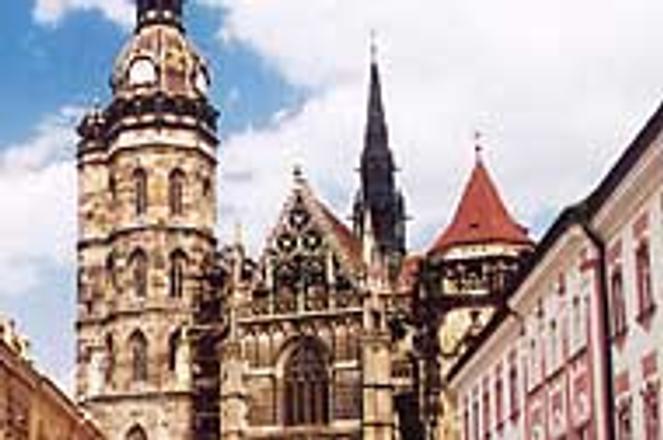A VIEW of St. Elizabeth's gothic cathedral from the Košice Old Town.photo: Chris Togneri
THE SPRAWLING ruins of Spiš castle, the towering High Tatra mountains and the grandiose St. Elizabeth's gothic cathedral may be the country's most visited destinations, but the dripstone caves of Slovakia's south-east have all the makings of an equally spectacular tourist treasure.
Of the 3,850 known caves in Slovakia, the most beautiful lie in the limestone areas of a region governed by the country's second largest city, Košice. For their unique qualities, these 'Slovenský Kras' karst caves (karst is landscape underlain by limestone) together with Hungary's Aggtelek underground cave system were included on the list of Unesco World Heritage sites in 1995. Dobšinská ice cave in Slovenský raj (Slovak Paradise) joined them five years later, in 2000.
Admired for the massive stalactites, stalagmites and 'ice-rivers' that dominate their spectacular interiors, the caves were first inhabited by humans during the Stone Age 35,000 years ago, although they have more recently become the permanent residence of 19 different types of bats.
SPIŠ castle is one of the country's most-visited above-ground attractions...photo: Chris Togneri
"Each of the caves is different, and each one is so beautiful that just looking at pictures of them forces you to pay a visit," says František Balún, head of the cultural department at the Košice regional office.
The cave most recently listed by Unesco, Dobšinská, offers an Alice-in-Wonderland walk through crystal falls, tables and columns of ice. Formed 7,000 to 9,000 years ago, the objects are part of an estimated 110,000 cubic metres of ice that fill the cave. A 26-metre thick ice floor used to serve as a natural skating rink and a training ground for Slovak figure skaters. Karol Divín, who won silver at the 1960 Olympics, was one of them.
According to Pavel Bella, a Slovak cave scientist, at only 920 metres above sea level Dobšinská is one of the lowest situated ice caves in the world. The most significant ice caves in the Austrian Alps have entrances starting at 1,420 metres.
...but Dobšinská ice cave is just as worth exploring.photo: TASR
Moreover, the Dobšinská ice cave is located in one of the most beautiful natural settings in the country - under the steep gorges and spuming waterfalls of the Slovak Paradise national park.
"The cave is magnificent. But I have to tell you, it's so cold there that I always can't wait to get back out in the sun. Once I get back in the hot sun, I have to cool myself off with a beer. And since I'm in a nature reserve, I also have to deal with being poisoned by oxygen," laughs Balún.
Most of the caves in the area are part of an underground network of 712 caves known in Slovakia as Slovenský Kras and in Hungary as Aggtelek. Although the system is the most extensively explored cave area in Europe, only four of the caves on Slovak territory are open to the public.
Domica, with the Baradla cave in Hungary, forms the longest underground cave system of 21 kilometres. The Slovak and Hungarian parts, though, are divided by an iron gate at the subterranean borderline. Both are littered with enormous onion-shaped stalactites, pagoda-like stalagmites and cascade lakes. These forms can be admired on the Domica side while sailing in a boat on the Styx river, which runs through the caves.
The cave with the greatest variety of bats, Jasovská, housed people from the Bronze Age to the era of the Roman Empire. Rediscovered in the 12th century, it bears the oldest cave inscription found in Slovakia. It was the first cave in the country to be made accessible to the public.
The Gombasecká cave is admired for its thin, 2-3 metre chalky needles that contrast sharply with the red surface of the rocky walls. The Krásnohorská cave contains the highest dripstone (rock deposited by dripping water) in the world, at 32.7 metres, which is listed in the Guiness Book of Records. Another Unesco site, the Ochtinská Aragonitová cave in the Revúca mountains, contains a rare and valuable formation of the aragonite mineral, which consists of calcium carbonate and usually results from hot spring deposits.
"Slovakia is a tiny country but one very rich in all kinds of natural beauty," enthuses Balún.


